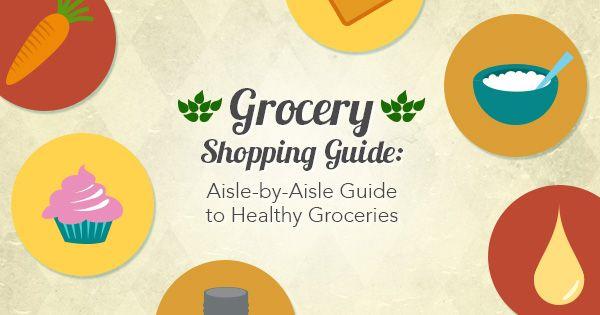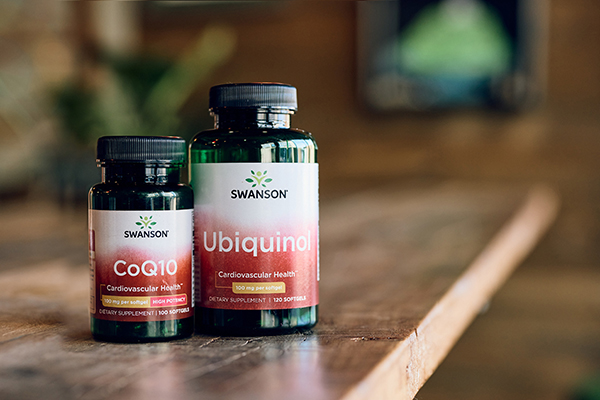Give Yourself Enough Time to Shop
We are often in a big rush to get our grocery shopping done. Perhaps picking up some stuff after work or quickly running an errand on a lunch break. This time crunch often causes us to grab at convenient processed foods, not check the ingredient list and nutrition facts or to not properly compare prices of multiple items. Plan your grocery shopping ahead of time, to allow adequate preparation and time in the store.
Healthy Shopping by Aisle
Make the most of your grocery store visits and fill your cart with healthy choices. The typical (good) advice that you hear is to stick to the perimeter of the grocery store. This allows you to focus on fresh produce, the bulk bins and meat, while ignoring the processed snacks in the middle. Sometimes, you simply need to grab something from one of the middle aisles. Here’s how to safely get through the entire store with a healthy load of affordable groceries.
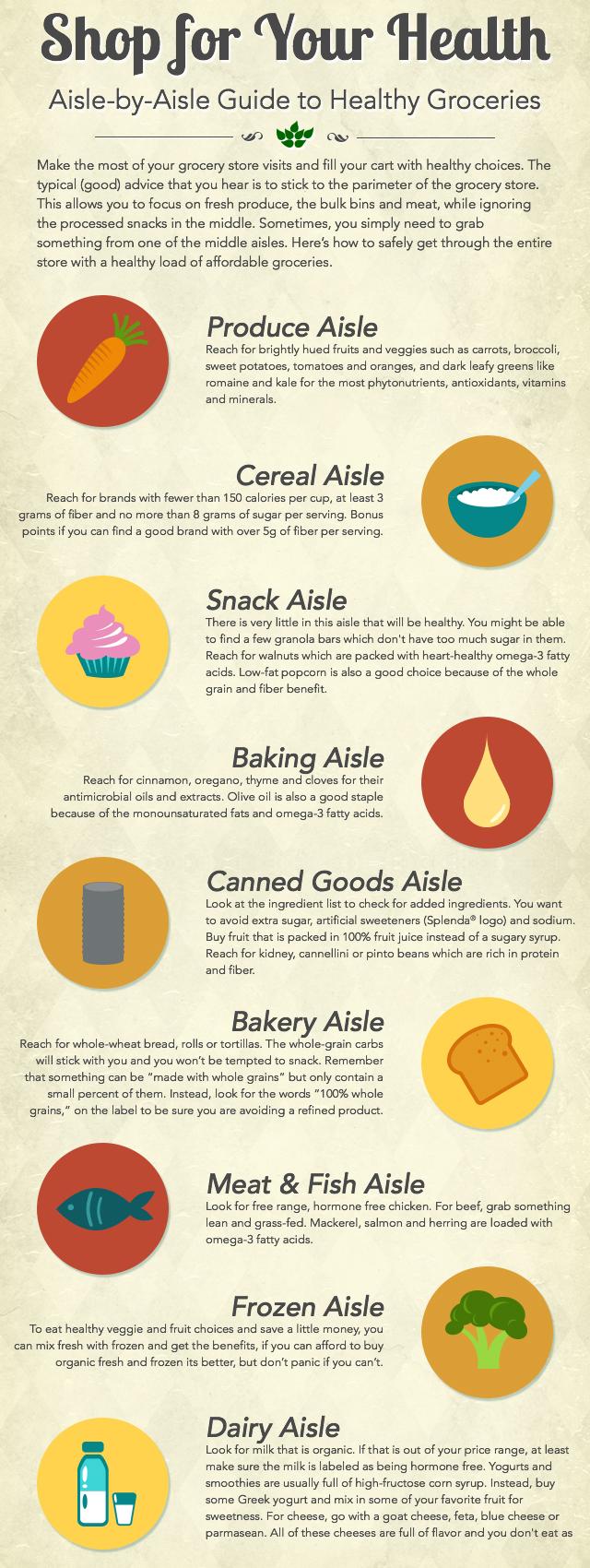
- Produce Aisle: Reach for brightly hued fruits and veggies such as carrots, broccoli, sweet potatoes, tomatoes and oranges, and dark leafy greens like romaine and kale for the most phytonutrients, antioxidants, vitamins and minerals.
- Cereal Aisle: Reach for brands with fewer than 150 calories per cup, at least 3 grams of fiber and no more than 8 grams of sugar per serving. Bonus points if you can find a good brand with over 5g of fiber per serving.
- Snack Aisle: There is very little in this aisle that will be healthy. You might be able to find a few granola bars which don't have too much sugar in them. Reach for walnuts which are packed with heart-healthy omega-3 fatty acids. Low-fat popcorn is also a good choice because of the whole grain and fiber benefit.
- Baking Aisle: Reach for cinnamon, oregano, thyme and cloves for their antimicrobial oils and extracts. Olive oil is also a good staple because of the monounsaturated fats and omega-3 fatty acids.
- Canned Goods Aisle: Look at the ingredient list to check for added ingredients. You want to avoid extra sugar, artificial sweeteners (Splenda® logo) and sodium. Buy fruit that is packed in 100% fruit juice instead of a sugary syrup. Reach for kidney, cannellini or pinto beans which are rich in protein and fiber.
- Bakery Aisle: Reach for whole-wheat bread, rolls or tortillas. The whole-grain carbs will stick with you and you won’t be tempted to snack. Remember that something can be “made with whole grains” but only contain a small percent of them. Instead, look for the words “100% whole grains” on the label to be sure you are avoiding a refined product.
- Meat & Fish Aisle: Look for free range, hormone free chicken. For beef, grab something lean and grass-fed. Mackerel, salmon and herring are loaded with omega-3 fatty acids.
- Frozen Aisle: To eat healthy veggie and fruit choices and save a little money, you can mix fresh with frozen and get the benefits, if you can afford to buy organic fresh and frozen its better, but don’t panic if you can’t.
- Dairy Aisle: Look for milk that is organic. If that is out of your price range, at least make sure the milk is labeled as being hormone free. Yogurts and smoothies are usually full of high-fructose corn syrup. Instead, buy some Greek yogurt and mix in some of your favorite fruit for sweetness. For cheese, go with a goat cheese, feta, blue cheese or parmasean. All of these cheeses are full of flavor and you don't eat as much as you would with a bag of regular shredded cheese.
Bonus Read: 5 Healthy Foods You Probably Haven't Given a Try (But Should)
Staples in a Healthy Pantry
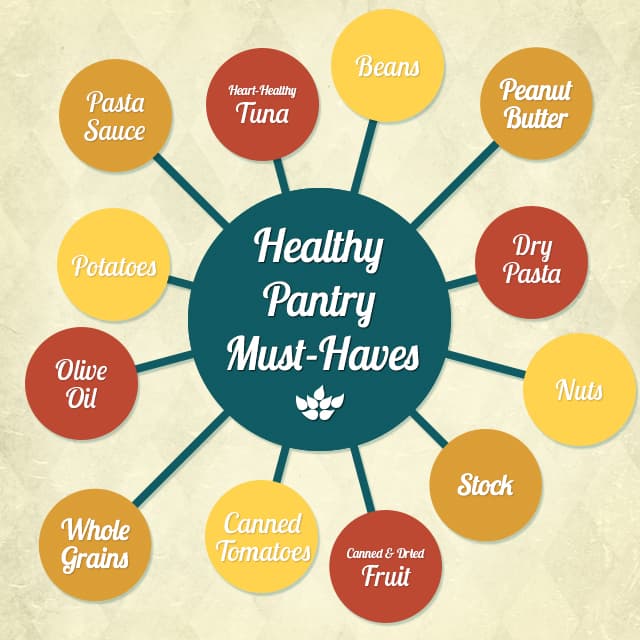
Keeping healthy foods on hand is the key to eating well and losing weight. The first step is cleaning out your pantry: toss out any unhealthy choices, including chips, cookies, candy and high-calorie, low-nutrient items. Now for a fresh start … we’re going to share the top 12 items you should stock in your pantry to help you plan healthier, more nutritious meals.
- Heart-healthy tuna: Tuna can help add healthy omega-3 fats and protein to a variety of dishes, including omelets, enchiladas and vegetable dips.
- Pasta sauce: Whipping up quick meals is a cinch when you have marinara sauce on hand. Spuds, vegetables and chicken breasts are transformed when topped with sauce and a sprinkle of cheese. Make English muffin pizzas or add the sauce to meatloaf.
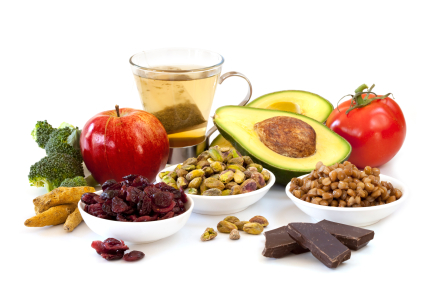 Potatoes: They are low in calories and high in fiber, vitamins and minerals. Sprinkle crunchy baked sweet potatoes with cinnamon. Baked white or sweet potato fries are delicious and much healthier compared to deep-fried potatoes. Try topping a baked potato with vegetables, cheese, beans, salsa, chili or whatever you have on hand.
Potatoes: They are low in calories and high in fiber, vitamins and minerals. Sprinkle crunchy baked sweet potatoes with cinnamon. Baked white or sweet potato fries are delicious and much healthier compared to deep-fried potatoes. Try topping a baked potato with vegetables, cheese, beans, salsa, chili or whatever you have on hand.
- Beans: Whether dried or canned, beans are an inexpensive alternative to animal protein. They're also an excellent source of fiber. Serve them as a side dish or add them to soups, omelets, tacos, casseroles or salads.
- Peanut butter: It's a great source of filling protein and healthy fats. Choose your peanut butter carefully; watch for added sugars, hydrogenated oils and other fillers. The best choice is an all-natural—and preferably organic—peanut butter made with just peanuts and salt. Peanut butter is fantastic on apples, bananas, celery and even waffles! You can also add it to Asian sauces and smoothies or use it in dips. Mix it with hot water and a splash of soy sauce for a flavorful pasta sauce or salad dressing.
- Dry pasta: It comes in a variety of shapes, sizes, and colors to help make meals more interesting. Get more fiber by choosing whole-grain or whole-grain blend pasta. Add dried pasta to soups and casseroles. Clean out the vegetable bin and make a nutritious pasta primavera or stir-fry.
- Olive oil: The fruity, peppery flavor of extra-virgin olive oil is ideal for salad dressings and paired with whole grains. Drizzle it on pasta dishes or on crusty bread with diced tomatoes to make bruschetta. It is known as“finishing oil.” Regular olive oil is perfect for sautéing meat and vegetables. Olive oil is a staple, but be sure to read this guide to learn more about other healthy cooking oils.
- Whole grains: Brown rice is a healthy, high-fiber whole grain. Couscous, bulgur and farro are available in whole-grain versions, too. These versatile grains complement any meat, fish, poultry or vegetable as a centerpiece or side dish. Couscous, bulgur and the seeds of the grain-like plant quinoa can be cooked quickly. For richer flavor, cook grains in stock. Combine them with colorful vegetables, nuts and seeds.
- Canned tomatoes: Having canned tomatoes on hand can make life a lot easier when you're creating quick and healthy meals. Tomatoes are rich in lycopene and vitamins A and C. They work in a variety of dishes, like soups and casseroles. Spike them with basil and other herbs to use as a quick sauce for pizza, meats, pasta or whole grains. Choose tomatoes with no added salt.
- Nuts: Don't think of nuts as just a party food. They're an excellent source of protein, fiber, good fats and other healthy nutrients. Nuts pair well with sweet and savory foods alike. Use unsalted nuts in cereals or as a meat alternative in pasta, grains, salads or vegetables. They’re also great with fruit or yogurt, in desserts or alone as a nutritious snack.
- Stock: Find low-sodium or unsalted chicken, beef and vegetable stock to add depth of flavor to your homemade, healthy entrees and side dishes. Use it as the base for a quick soup or sauce. Spice up rice and whole grains by replacing cooking water with flavorful stock.
- Canned and dried fruit: Rich in nutrients, loaded with antioxidants and fiber, and low in calories, fruit belongs at every meal. Canned fruit makes a delicious snack or dessert alone or over yogurt, ice cream and waffles. Dried fruit adds pizzazz to salads, cereals and fish. Toss a handful of dried fruit with nuts for the perfect healthy snack. Be sure to look for products with no added sugar.
Bonus Read: 5 "Healthy" Foods that are Killing Your Diet
Should You Buy Organic Foods?
There is a constant debate going on about whether or not the organic foods benefits are worth the price and availability. Next time you venture out to your local grocery store or market, or even when considering your next harvest, think about these top reasons for eating organically.
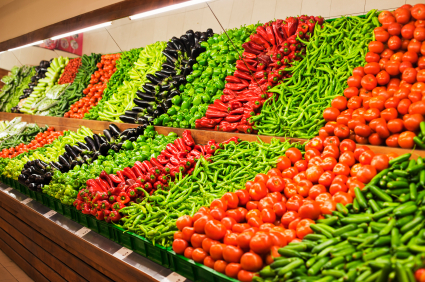 It leads to healthier neighbors. This one is for the farmers. People who live near farming plots where pesticides are being sprayed are at risk to exposure. Planting organically would eliminate this risk.
It leads to healthier neighbors. This one is for the farmers. People who live near farming plots where pesticides are being sprayed are at risk to exposure. Planting organically would eliminate this risk.
- It leads to healthier kids. Diets that contain pesticide-induced foods are more common in children than household or school sprays, which can negatively affect neurological development.
- Organic farming uses less energy. Cornell University researcher David Pimentel found that organic corn and soybeans can be grown with thirty percent less energy than conventionally grown corn and soybeans, and still produce the same yield.
- Organic farming helps mitigate global-warming emissions. According to research done at the Rodale Institute, we could pull up to 25 percent of climate-warming carbon emissions out of the atmosphere if all U.S. farmland were converted to organic farmland.
- Organic produce contains more nutrients. Synthetic fertilizers can destroy nutrient levels in the foods being grown. Virginia Worthington, a clinical dietician and advocate for organic foods, surveyed more than 40 years’ worth of studies and found that the results showed that organic produce had much higher levels of vitamin C, iron, magnesium, and phosphorus than conventional produce.
7 Ways to Save Money on Your Grocery Bill
Did you know the average American family of four tosses out over $1,300 in groceries each year? Jonathon Bloom, author of American Wasteland: How America Throws Away Nearly Half of Its Food (and What We Can Do About It), says fruit and vegetables are the # 1 most-wasted food. Why? People tend to forget about the food in the refrigerator and then it just goes to waste. Here’s how to prevent wasting food and save some money.
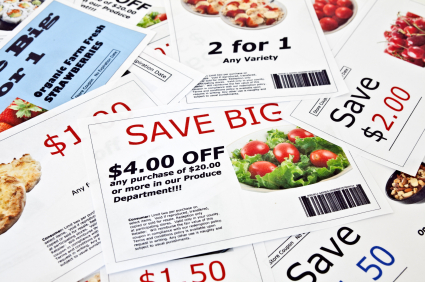 Make a list. Try and stick to it, so you’re not tempted by all those specials on the end caps or on the shelves at eye-level in the store.
Make a list. Try and stick to it, so you’re not tempted by all those specials on the end caps or on the shelves at eye-level in the store.
- Plan your meals. It takes some time, but planning out your meals will make sure that the items are your list are items you need and don't go to waste.
- Be a coupon skeptic. Many people tend to overspend because they “have a coupon” for something. Before you put the item in your cart, ask yourself if you would buy it without the coupon.
- Don’t shop while you’re hungry. You’re much more tempted to add calorie-rich foods to your cart if you haven’t eaten before heading to the grocery store.
- Buy fruits and veggies in season. They’re cheaper and taste better. Buy frozen when the fresh options are out of season.
- Go vegetarian. Skip eating meat once or twice a week, and you could slash your grocery bill by 25%.
- Shop alone. Bringing your significant other and/or children can lead to distractions and extra (unplanned) purchases.
One more thing: Don't forget to bring and use your reusable bags!
